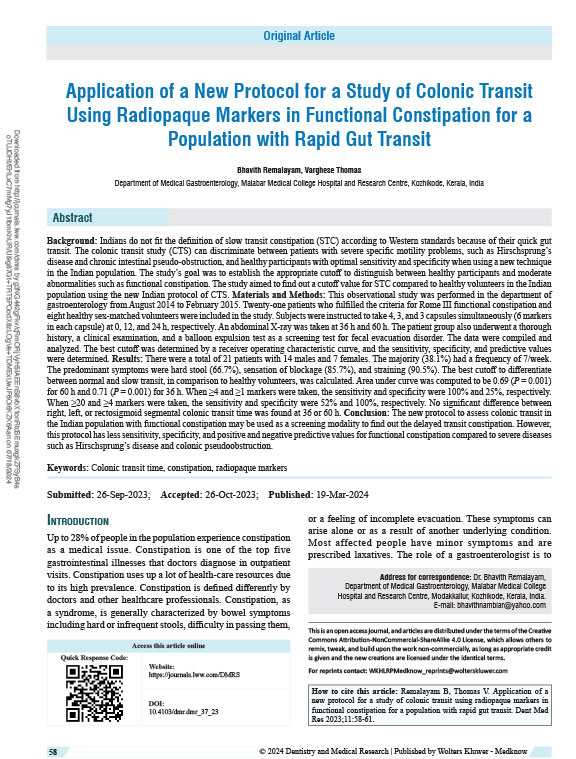Application of a New Protocol for a Study of Colonic Transit Using Radiopaque Markers in Functional Constipation for a Population with Rapid Gut Transit
July-December 2023
Abstract
Background:
Indians do not fit the definition of slow transit constipation (STC) according to Western standards because of their quick gut transit. The colonic transit study (CTS) can discriminate between patients with severe specific motility problems, such as Hirschsprung’s disease and chronic intestinal pseudo‑obstruction, and healthy participants with optimal sensitivity and specificity when using a new technique in the Indian population. The study’s goal was to establish the appropriate cutoff to distinguish between healthy participants and moderate abnormalities such as functional constipation. The study aimed to find out a cutoff value for STC compared to healthy volunteers in the Indian population using the new Indian protocol of CTS.
Materials and Methods:
This observational study was performed in the department of gastroenterology from August 2014 to February 2015. Twenty‑one patients who fulfilled the criteria for Rome III functional constipation and eight healthy sex‑matched volunteers were included in the study. Subjects were instructed to take 4, 3, and 3 capsules simultaneously (6 markers in each capsule) at 0, 12, and 24 h, respectively. An abdominal X‑ray was taken at 36 h and 60 h. The patient group also underwent a thorough history, a clinical examination, and a balloon expulsion test as a screening test for fecal evacuation disorder. The data were compiled and analyzed. The best cutoff was determined by a receiver operating characteristic curve, and the sensitivity, specificity, and predictive values were determined.
Results:
There were a total of 21 patients with 14 males and 7 females. The majority (38.1%) had a frequency of 7/week. The predominant symptoms were hard stool (66.7%), sensation of blockage (85.7%), and straining (90.5%). The best cutoff to differentiate between normal and slow transit, in comparison to healthy volunteers, was calculated. Area under curve was computed to be 0.69 (P = 0.001) for 60 h and 0.71 (P = 0.001) for 36 h. When ≥4 and ≥1 markers were taken, the sensitivity and specificity were 100% and 25%, respectively. When ≥20 and ≥4 markers were taken, the sensitivity and specificity were 52% and 100%, respectively. No significant difference between right, left, or rectosigmoid segmental colonic transit time was found at 36 or 60 h.
Conclusion:
The new protocol to assess colonic transit in the Indian population with functional constipation may be used as a screening modality to find out the delayed transit constipation. However, this protocol has less sensitivity, specificity, and positive and negative predictive values for functional constipation compared to severe diseases such as Hirschsprung’s disease and colonic pseudoobstruction.

